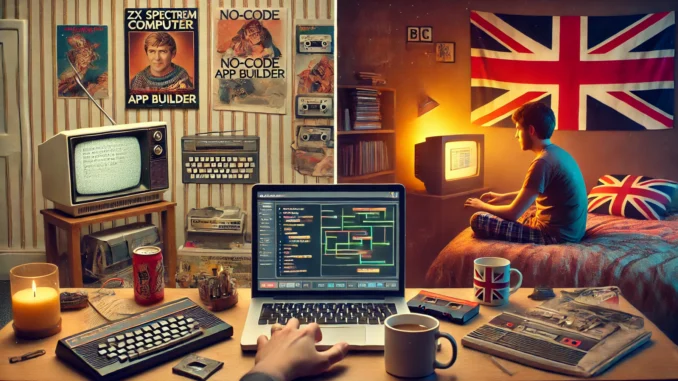
Introduction
If you grew up hunched over a cassette-loaded microcomputer, painstakingly typing out lines of BASIC from the back of a magazine, you probably believed that coding was a kind of digital magic. There was something uniquely empowering about writing a few commands and watching your name scroll endlessly across the screen—or, if you were really ambitious, crafting a primitive game that involved bouncing balls and beeping sound effects.
Fast-forward to today, and we find ourselves in a world of no-code platforms and AI-assisted development tools. You can now build a fully functioning app by dragging and dropping a few components—or even just telling a chatbot what you want. The craft of coding, once a rite of passage for tech-savvy Gen-Xers, seems to be morphing into something new entirely.
So the question arises: in 2040, will anyone still write code? Or will the very notion of “coding” be relegated to a nostalgic niche, much like dial-up tones and floppy disks? Let’s explore what we’ve gained, what we may be losing, and what our generation’s early digital tinkering still has to teach the future.
Historical Context
For many Gen-Xers in the UK, coding wasn’t just a skill—it was a form of rebellion. It meant taking control of your technology at a time when the machines were just beginning to enter our homes. The BBC Micro, a staple of school computer labs and the centrepiece of the BBC Computer Literacy Project, didn’t just teach us programming—it gave us agency. With Locomotive BASIC on an Amstrad CPC 464 or Sinclair’s ZX Spectrum, we wrote our own rules. Magazines like Your Sinclair or Amstrad Action handed us games and utilities in code form, line by line, and we dutifully typed them in.
That era made coding feel tactile and intimate. Syntax errors were part of the journey. Sometimes, the program didn’t load. Sometimes, the cassette needed rewinding, just so the bytes could try again. We learned logic, structure, and above all, patience. There was no GitHub, no Stack Overflow—just trial and error, maybe a friend from school, and the occasional Maplin visit to grab a new cassette.
These early experiences shaped not only our technical skills but our creative outlook. Writing code was making something from nothing. It instilled a mindset that persists today: technology isn’t just something we consume—it’s something we shape.
Modern Implications
Now, let’s look at today’s landscape. No-code platforms like Webflow, Bubble, and Glide allow users to build everything from e-commerce sites to complex databases without writing a single line of code. AI tools such as GitHub Copilot and Replit Ghostwriter are transforming how developers approach problem-solving—offering suggestions, autocompleting functions, even writing entire scripts based on natural language prompts.
It’s tempting to view this as the death of programming. But that’s too simplistic. What we’re seeing is a redistribution of creativity. People who were once locked out of the digital creation space—those without formal training, with disabilities, or with different learning styles—are now empowered to build.
Still, something’s changed. When code becomes invisible, we lose a degree of intimacy with the machine. There’s a difference between choosing from a menu and crafting a system line by line. Convenience can flatten innovation. And when the tooling is owned by large platforms, are we truly in control of what we make?
This isn’t to say that no-code tools aren’t revolutionary—they are. But as someone who once debugged a broken For…Next loop on a Sunday afternoon, I can’t help but ask: is easy always better?
Future Outlook
Looking ahead to 2040, it’s plausible that entire software products will be built through voice commands or visual cues. AI will anticipate our needs, automate optimisations, and perhaps even detect and solve problems before we’re aware of them.
But will that make traditional coding obsolete? Not entirely. Much like how woodworking persists in an age of flat-pack furniture, human-authored code may become the domain of artisans, performance obsessives, and those who want to understand the machine at a deeper level. Coding might evolve from being a foundational skill to a specialist craft.
There’s also a philosophical question: if software builds itself, who decides what it builds for? The future of coding might rely less on syntax and more on ethical frameworks, creative intent, and critical thinking—the very skills cultivated by that early generation of bedroom coders.
So perhaps the role of Gen-X is not to insist that everyone learn to code, but to ensure that those who create—whether with code or through no-code—do so with curiosity, care, and a sense of digital responsibility.
Conclusion
Our generation didn’t just learn to code—we learned to question. To poke, prod, and reimagine. That spirit doesn’t require curly braces or semicolons. It requires the courage to make, break, and build anew.
In a world where machines increasingly shape our digital landscape, there’s still value in understanding how they work—and even more in choosing why they should. Whether you’re still writing code or just telling an AI what to do, the heart of making remains the same: to create with intention.
Because in 2040, the real question won’t be whether we can code. It will be whether we still care to.
Do you remember your first program? Still tinkering today—or happily no-code? Share your story below.

Leave a Reply